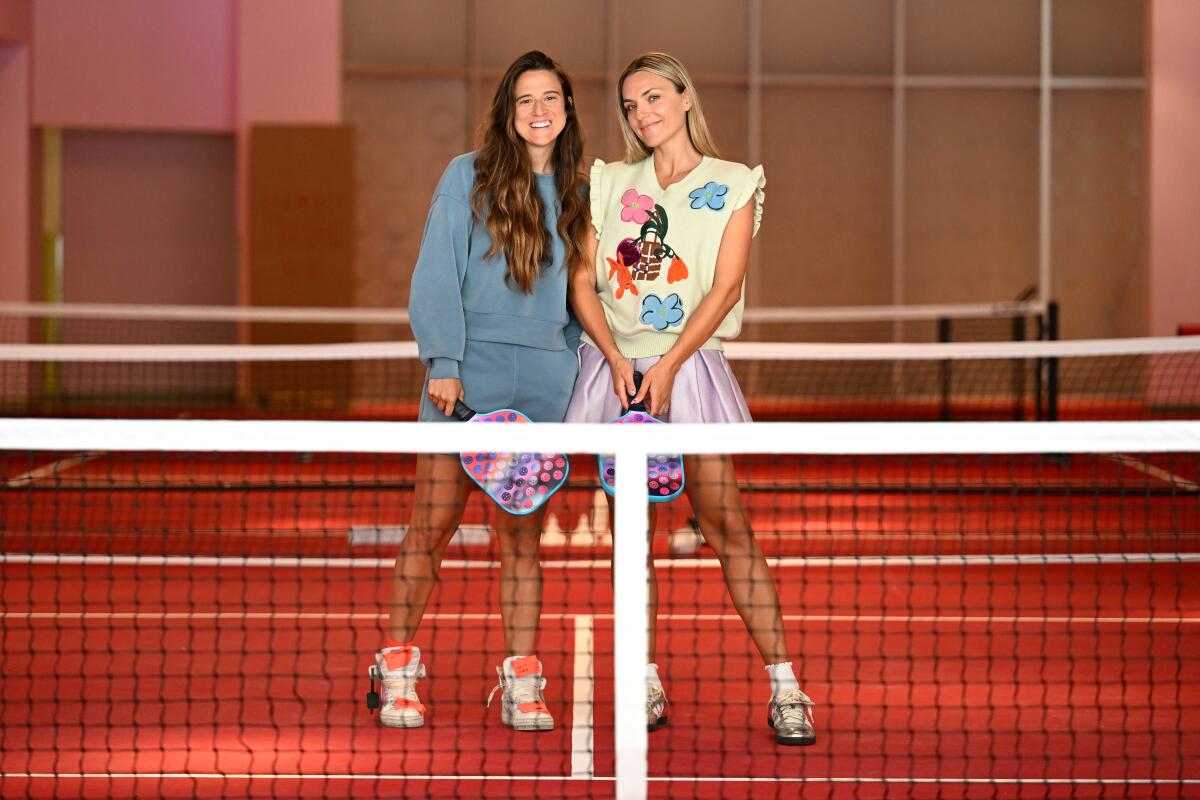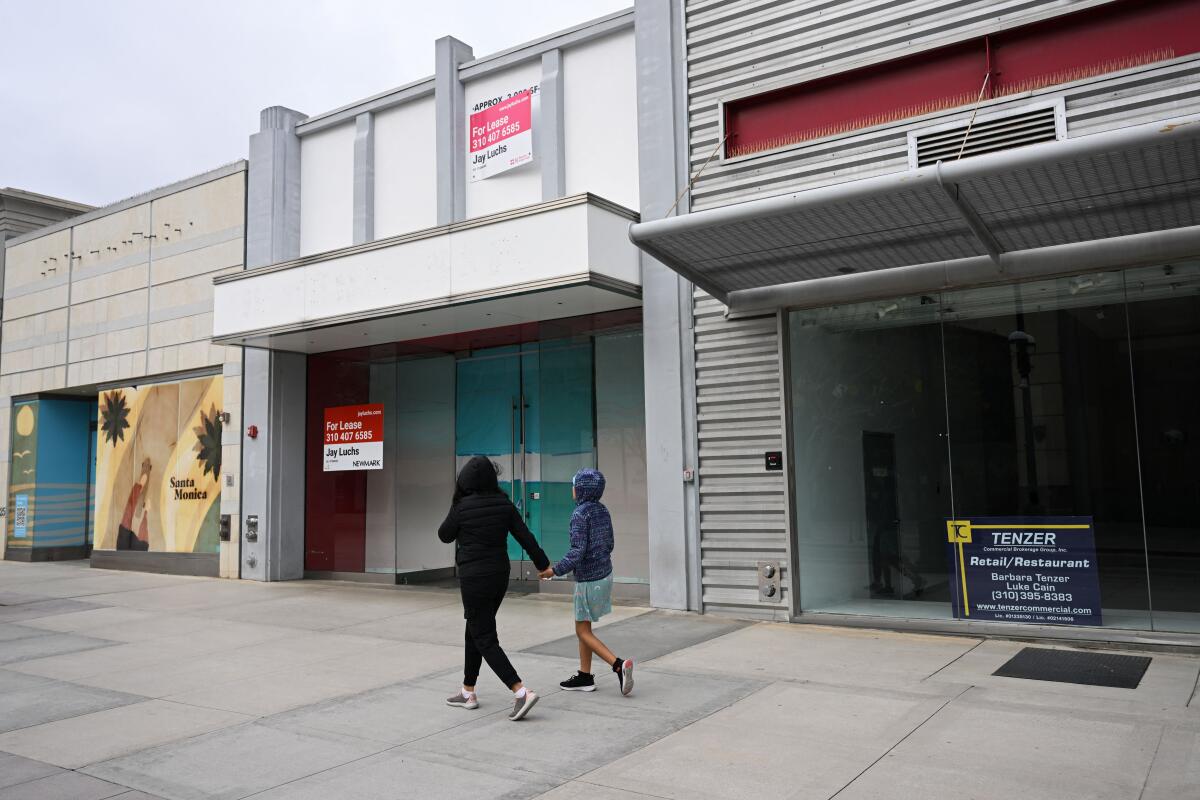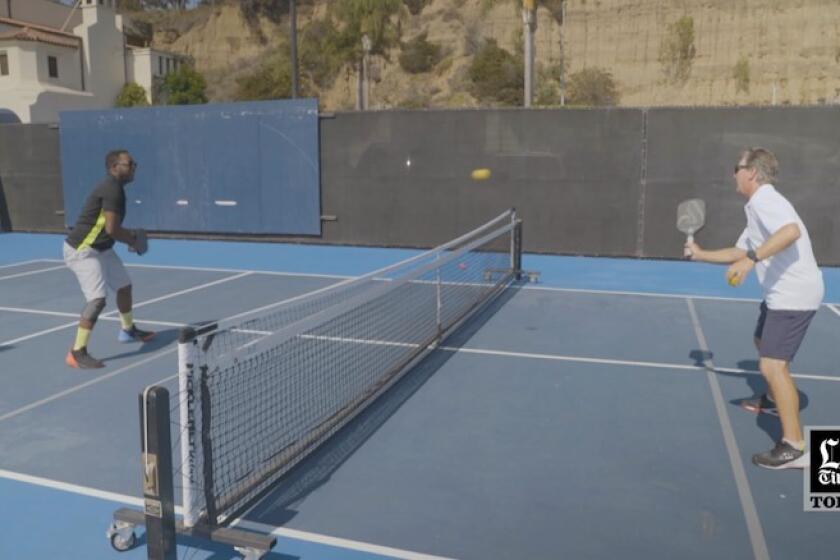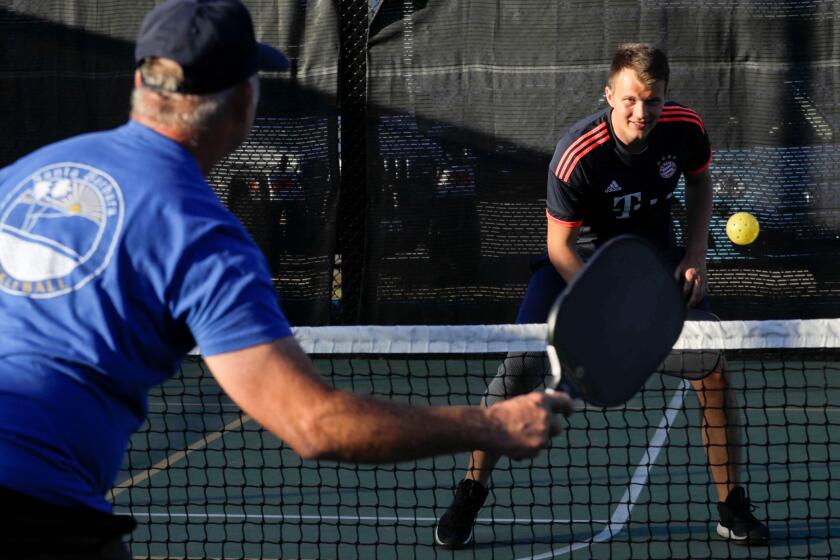Can pickleball cure what’s ailing Santa Monica’s Third Street Promenade?

- Share via
Could pickleball be the answer to America’s big-box retail crisis? In Santa Monica, it may be a start.
Pickle Pop, an indoor pickleball venue where players can reserve court time, opened its doors on Santa Monica’s Third Street Promenade, one of the city’s popular shopping areas, on Saturday. Part sports club, part clothing retailer, part restaurant, Pickle Pop positions itself as an inviting space for serious athletes and social picklers alike, offering a relatively affordable alternative to waiting in line to play at public parks.
The 10,000-square-foot space used to be an Adidas store.
Pickle Pop co-founder Steph McCaffrey works in an office near the Third Street Promenade and often walks through the three-block pedestrian shopping district to grab coffee. After a while, she began to see the many vacant storefronts as an opportunity.
“I remember walking around here pre-COVID, and this was like the street to be at in Southern California,” she said. These days, she observes fewer shoppers and tourists, and the area has felt quieter.
“So what we decided to try and do was basically figure out if we could arbitrage lower rents on big-box retail space for shorter-term locations and see if something worked,” she said. “And then if it worked, we could extend.”
A week ahead of its official opening, the space was already hosting small-scale corporate events on its burgundy courts after eager players slid into Pickle Pop’s Instagram DMs offering to pay up for early access.
Malls and big-box stores nationwide are struggling as the retail landscape evolves and consumers increasingly opt to shop online, and Santa Monica’s Third Street Promenade, long considered a hot shopping destination in Southern California, has felt the effects of this bricks-and-mortar slump. Key tenants, including a flagship Banana Republic and Old Navy on the same block, left in 2021.
But some of the Promenade’s vacant storefronts have presented new opportunities — and great deals — for tenants who see the value in the beachside shopping district steps from one of Southern California’s wealthiest ZIP Codes.
The Promenade is not alone in its retail struggles.
Gap Inc. — which owns Gap, Old Navy, Athleta and Banana Republic — announced in 2020 that it planned to close 350 Gap and Banana Republic stores in the next three years. And in June, the owners of San Francisco’s largest mall announced they were pulling the plug after an announcement that one of its largest tenants, Nordstrom, was closing its store there.
In an effort to course correct, Santa Monica city officials have been working to remove some of the red tape required for new businesses to launch. Some landlords who own space on the Third Street Promenade have become more open-minded to accepting unconventional tenants rather than national chains.
Making a space ‘pickleball-able’
Partners in business and in life, McCaffrey and co-founder Erin Robertson conceived the idea for Pickle Pop earlier this summer and moved quickly. Even though not all vacant retail storefronts are, as Robertson says, “pickleball-able,” many are with a reasonably low lift.
Robertson is a fashion designer who won season 15 of the Bravo competition series “Project Runway”; McCaffrey is an investor at Anthos Capital, a consumer-focused growth equity fund, and a former professional soccer player.
In an area where there is little undeveloped land and neighbors are likely to push back at new housing, some see the declining malls as ideal places to build.
McCaffrey was inspired by the successful retail pop-ups that Robertson ran before the pandemic but wanted to go bigger for Pickle Pop. She pitched the idea to Robertson: “Maybe, instead of doing a traditional retail pop-up with a space as big as a cafe, we do an experiential retail concept where you sell a pickleball-focused line, and we have three or four pickleball courts in the space,” she said.
Robertson loved the idea. “I feel like just retail is never enough, and I’ve actually always felt that way,” she said, especially in large spaces that can accommodate experience-based businesses.
Pickle Pop gave Robertson a vast canvas to show off her eye for interior design: The cavernous space has three pickleball courts in a custom dark red, a seating area filled with space-age furniture sourced from the Rose Bowl Flea Market, and sumptuous baby-blue velvet curtains cloaking the walls.

Pickle Pop will also serve food and drinks from nearby Mexican joint Lanea — “Our favorite place in town,” McCaffrey said — prepared in Pickle Pop’s own kitchen, and sell merchandise designed by Robertson, including pickleball paddles printed with an ombre rainbow pattern. They hope to have their alcohol license by October and, until then, will be slinging drinks on the weekends thanks to an arrangement with Lanea.
Anyone can play, but a $55-a-month membership offers reservations for court times and ticketed events, plus discounts on hourly play. Non-members pay around $20 an hour to play, while member prices are about $12 per player.
McCaffrey and Robertson signed a lease until the end of January, but they say their business is just getting started. They are optimistic about a lease extension and are finalizing plans to open two bigger locations in the Los Angeles metro area.
It seems like a good time to bet on pickleball, America’s fastest-growing sport: 36.5 million adult Americans played the game at least once in 2022, according to a report released in January by the Assn. of Pickleball Players (formerly known as the Assn. of Pickleball Professionals). Nearly half of the 36.5 million said they planned to play more often in the next six months than they had in the previous six-month period.
“If you try pickleball, you’ll find that it’s actually a lot of fun, number one, and number two, you can actually improve pretty fast,” said Ho Nguyen, the USA pickleball ambassador for Santa Monica. Nguyen also consults for Pickle Pop and will teach lessons there.
The sport is sweeping the country, but a backlash over noise is turning neighbor against neighbor.
Nguyen got into pickleball in 2019 and has become an evangelist for the sport. He instantly loved the collegial, social culture and its low barrier to entry. “Isn’t that cool to have a sport where a parent can play with their teenager or a kid or even grandparents? I can’t think of any other sport,” he said.
McCaffrey and Robertson were drawn to the Promenade in particular for their venture. “I think there was a feeling like it was an area with opportunity that was currently on a down,” McCaffrey said, and in an iconic location. Eventually, she predicted that a storefront would become available to lease at a “favorable rate,” and when the right opportunity appeared, they pounced.
“I think this is a great building that needs some love,” she said. “And when you’re a tenant and buildings have been vacant for a really long time, you have an opportunity to get attractive terms.”
Problems at the Promenade

Retail is struggling everywhere, but the Promenade, and Santa Monica more broadly, have dealt with their own set of issues in recent years. The three-block pedestrian shopping district was hit hard in 2020 as the city’s booming tourism industry dried up. And since the pandemic, the area has garnered criticism about public safety and the homeless population, and controversy about the legitimacy of such claims.
Any stigma of buying fashion secondhand is gone. Shoppers are running mini resale businesses as the investment value of certain luxury brands has soared.
The Promenade, like most malls, had a surge of success from the mid-1990s until the 2010s. Now, the strip is entering a new phase, said Andrew Thomas, chief executive of Downtown Santa Monica Inc., the nonprofit that helps manage the area. “I think what we’re starting to see is a lot more experiential concepts coming into downtown,” Thomas said. “Athletics are big, as is food and dining.”
Earlier this year, a Madewell closed and was quickly replaced by a Wilson tennis store. A John Reed Fitness gym also opened this year.
David Martin, Santa Monica’s community development director, sensed that challenges were on the horizon for the Promenade in the mid-2010s. “I think there’s a tendency to think that COVID caused all this, and certainly it contributed,” he said. “But we were seeing it start to happen in 2015, 2016 with the changes in retail. We were starting to hear that some of the stores weren’t renewing their leases.”
Thomas said that the city is working to address concerns about public safety and homelessness in Santa Monica that were exacerbated during the pandemic. “We hear from the Santa Monica police that crime is actually down in downtown, and on the Promenade reported criminal activity is down significantly,” he said, “but we do have behavioral issues that we see here that are really troubling.”
On a few recent visits to the Promenade, the streets were clean and relatively quiet, with the blocks on the southernmost end of the strip attracting the most attention.
One sunny Monday afternoon, outdoor dining tables were nearly full at Barney’s Beanery and Johnny Rockets. Two people caught some shade under a pair of dinosaur-shaped sculptures. Community “ambassadors” in uniform pushed trash bins and swept up debris.
The occupancy rate for the Promenade is 77.6%. — up from 67% in 2021 — according to data from DTSM.
Pickle Pop’s 10,000-square-foot space is on the most sparsely populated block on the Promenade, which has a vacancy rate of 34.6%, according to DTSM. The former tenant, Adidas, still has a presence on the Promenade, but downsized to a smaller location one block south before the pandemic.
Engineering a revival
Santa Monica already has a leg up by being a nationally known shopping destination, and the city has poured resources into reviving the retail experience downtown in the last couple of years. There have been major changes to the ordinances governing use of space on the Promenade that make it easier for new businesses to open quickly, Martin said.
One major change: The city changed the process to obtain an alcohol permit, making it easier for new businesses on the Promenade to secure one.
Additionally, conditional-use permits are no longer required for most businesses that have entertainment uses and want to sell alcohol, formerly a major obstacle for businesses.
“It was pretty strict before,” Martin said. A few years ago, Santa Monica limited the number of restaurants and liquor licenses it distributed per block. This didn’t slow activity when mostly traditional retail tenants filled the Promenade’s storefronts, but now, things are different. “That just doesn’t work in today’s retail environment,” Martin said.
Pickle Pop, Martin said, was “guaranteed to be able to have an alcohol license as part of their operation.”
Local commercial real estate brokers characterize any current “down” as cyclical. Rafael Padilla, a principal at Par Commercial Brokerage who has worked on deals on the Westside for 38 years, said that Santa Monica has too much to offer for retail to suffer long term.
“The disposable income, the density, the businesses, the ocean, the tourists, everything’s here. So it’s not going away,” he said. “We’re just going to see things adjust.”
A pickleball court, he said, may not have been able to secure a spot on the Promenade four years ago. “Now, they can.”
Barbara Tenzer, founder of Tenzer Commercial Brokerage Group, whose primary focus is the Promenade and downtown Santa Monica, said that exciting new tenants are coming. Some are expected to drive foot traffic, including the forthcoming restaurant HQ Gastropub, which she said plans to have a speakeasy in the basement, outdoor dining on the ground floor, and a rooftop bar and lounge. (Tenzer has brokered deals on the Promenade for more than three decades.)
The brokers also said that the Promenade’s large storefronts can be harder to find tenants for.
“Look, if the promenade was all 1,500-square-foot spaces, it would all be leased,” Tenzer said. “But that’s not what we have. The spaces are 150 feet deep, a standard building is 50 feet wide, so that’s like 7,500 square feet, yeah? That’s a lot of space.”
“If a landlord is holding out for one tenant to take 45,000 [or] 50,000 square feet, yeah, your pool of tenants [is] going to be shallow,” Padilla said. “If you are looking for tenants to take anywhere from 2,500 to 5,000 square feet, you’ve got a deeper pool to play in. That’s just an economic decision for the landlord to make.”
Could this prove to be a perfect storm for businesses like Pickle Pop?
“The dream is [that] this would not leave,” Robertson said. “We would love to keep this going and then also expand to other neighborhoods of L.A.”
More to Read
Inside the business of entertainment
The Wide Shot brings you news, analysis and insights on everything from streaming wars to production — and what it all means for the future.
You may occasionally receive promotional content from the Los Angeles Times.














